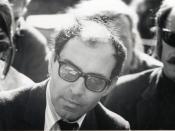"Jean-Luc Godard once said that every movie must have a beginning, a middle and an end - but not necessarily in that order. Tarantino's scripts seem inspired by that notion, and the same goes for Go, which begins at one key point in its story, backtracks to fill in details, then throws in the perspective of other characters." Although many reviews of this movie compare it to Pulp Fiction in its style and sequencing, Go's creative script and unique style of narration allow it to stand on its own. Distributing the plot information through four main narrators, the viewer is able to partake in a more unrestricted and comprehensive version of the story.
The first scene of the movie opens in medias res, leaving the viewer uncertain of the characters identities or the significance of their relationship. The viewer later learns that the first narrator that the viewer is introduced to is Claire, a young woman with dark hair and large eyes.
She delivers a monologue about Christmas and the element of the surprise gift to an unknown person. The notion of surprises possibly alludes to the fact that the movie is shot out of sequence and the viewer is surprised to learn what is coming next.
The second narrator introduced to the audience is Ronna, a young supermarket cashier trying to earn enough rent money to avoid being evicted from her apartment. She reluctantly agrees to take on another extra shift for fellow supermarket employee, Simon, so that he may go to Las Vegas with his friends. He offers her cash up front as an incentive and to pay her rent debt. At this point in the film, the narration is completely objective, as the viewer has not been given any insight into Ronna's personality or...



Good research
I think you analyed the film very well, but remember that you are always able to go further in detail. Good effort however
2 out of 2 people found this comment useful.